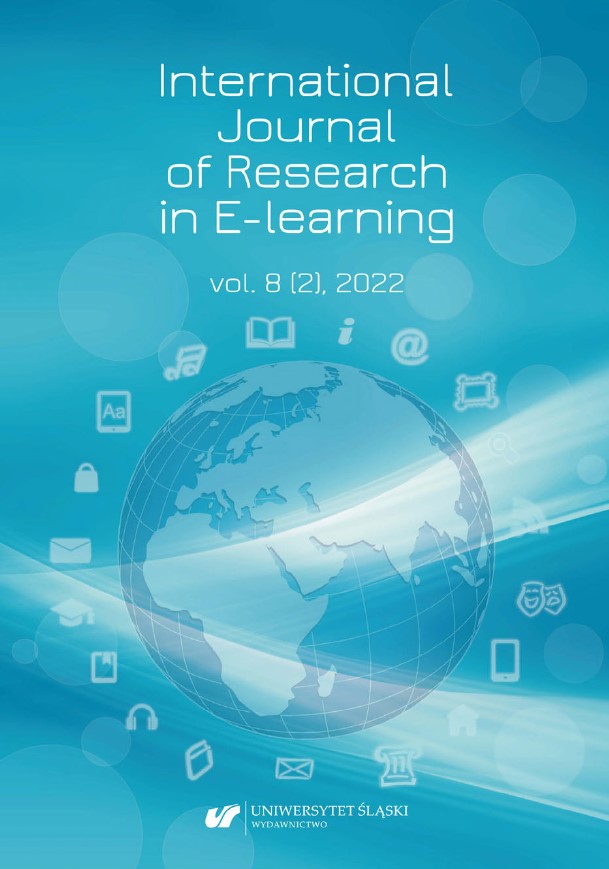Anderson, T., Rourke, L., Garrison, D. R., & Archer, W. (2001). Assessing teaching presence in computer conferencing context. Journal of Asynchronous Learning Networks, 5(2), 1–17. http://dx.doi.org/10.24059/olj.v5i2.1875
Google Scholar
Doliner, L., Nazarov, V. (2021). Adapting the e-course for teacher training in the teacher professional development system. E3S Web of Conferences 295, 05002 (2021). https://doi.org/10.1051/e3sconf/202129505002
Google Scholar
Douglas-Faraci, D. (2010). A correlational study of six professional development domains in e-learning teacher professional development. MERLOT Journal of Online Learning and Teaching, 6(4), 754–766.
Google Scholar
Ernest, P., Guitert Catasus, M., Hampel, R., Heiser, S., Hopkins, J., Murphy, L., & Stickler, U. (2013). Online teacher development: collaborating in a virtual learning environment. Computer Assisted Language Learning, 26(4), 311–333. https://doi.org/10.1080/09588221.2012.667814
Google Scholar
Garrison, D. R. (2011). E-learning in the 21st century: A framework for research and practice (2nd ed.). London, UK: Routledge/Taylor and Francis. ISBN: 978-0415885836
Google Scholar
Garrison, D. R., Anderson, T., & Archer, W. (2000). Critical inquiry in a text-based environment: Computer referencing in higher education. Internet and Higher Education, 2(2-3), 1–9. https://doi.org/10.1016/S1096-7516(00)00016-6
Google Scholar
Garrison, D.R. & Vaughan, N.D. (2012). Blended learning in higher education: Framework, principles, and guidelines. Hoboken: John Wiley & Sons. ISBN: 978-1-118-26955-8
Google Scholar
Hanson-Smith, E. (2007). Critical issues: Places and spaces. In J. L. Egbert, E. Hanson-Smith (Eds.), CALL Environments (pp. 42–58). Alexandria, VA: TESOL. ISBN: 978-1931185431
Google Scholar
Hoven, D. (2006). Designing for disruption: Remodelling a blended course in technology in (language) teacher education. In L. Markauskaite, P. Goodyear & P. Reimann (Eds.), Proceedings of the 23rd Annual ASCILITE Conference: Who’s learning? Whose technology? (pp. 339–349). Sydney, Australia: University of Sydney. ISBN: 9781920898489
Google Scholar
Impedovo, M. A., & Malik, S. K. (2019). Pakistani teacher-educator professional learning through an international blended course. Open Praxis, 11(2), 157–166. http://doi.org/10.5944/openpraxis.11.2.928
Google Scholar
Mackenzie, D., Promnitz-Hayashi, L., Jenks, D., Geluso, J., Delgado, R., Castellano, J., & Hinkelman, D. (2011). Blended learning spaces: Synchronous blending. The JALTCALL Journal, 7(1), 43–60. https://doi.org/10.29140/jaltcall.v7n1.107
Google Scholar
McDonald, K. (2008). Fostering departmental communication and collaboration with online discussion forums. The JALTCALL Journal, 4(2), 17–28. https://doi.org/10.29140/jaltcall.v4n2.60
Google Scholar
Medina Garriguez, C., Hiasat, L., & Billy, R. J. F. (2019). Basic linguistics for English language teachers: A community for professional development online. TESL-EJ, 23(1), 1–21. ISSN: 1072-4303
Google Scholar
Müller-Hartmann, A., & Kurek, M. (2016). Virtual group formation and the process of task design in online intercultural exchanges. In R. O’Dowd & T. Lewis (Eds.), Online Intercultural Exchange (pp. 145–163). London: Routledge. ISBN: 978-1138932876
Google Scholar
Picciano, A.G. (2009). Blending with purpose: The multimodal model. Journal of Asynchronous Learning Networks, 13(1), 7–18. http://dx.doi.org/10.24059/olj.v13i1.1673
Google Scholar
Pineda, P., & Celis, J. (2018). The maelstrom of online programs in Colombian teacher education. Education Policy Analysis Archives, 26(114). http://dx.doi.org/10.14507/epaa.26.3873
Google Scholar
Prestridge, S. (2016) Conceptualising self-generating online teacher professional development. Technology Pedagogy and Education, 26(1), 85–104. 10.1080/1475939X.2016.1167113
Google Scholar
Ranjan, P. (2020). Is blended learning better than online learning for B.Ed students? Journal of Learning for Development – JL4D, 7(3), 349–366. https://doi.org/10.56059/jl4d.v7i3.412
Google Scholar
Razak, R. A., & Yusop, F. D. (2013). Designing framework of electronic continued professional development for teachers (e-CPD). Paper presented at the Annual International Conference on Management and Technology in Knowledge, Service, Tourism & Hospitality 2013 (SERVE 2013), Jakarta, Indonesia.
Google Scholar
Satar, H. M., & Akcan, S. (2018). Pre-service EFL teachers’ online participation, interaction, and social presence. Language Learning & Technology, 22(1), 157–183. DOI: https//dx.doi.org/10125/44586
Google Scholar
Son, J.-B. (2000). Teacher development in e-learning environments. Retrieved from https://www.academia.edu/21190532/Teacher_development_in_e_learning_environments (accessed 1 July 2021).
Google Scholar
Staker, H. & Horn, M.B. (2012). Classifying K-12 blended learning. Lexington: Innosight Institute. Retrieved from https://aurora-institute.org/wp-content/uploads/Classifying-K-12-blended-learning2.pdf (accessed 13 October 2022).
Google Scholar
Thomas, S. (2011). Virtual communities of practice: An inquiry into the creation, benefits, motivations, enablers and barriers to participation. The JALTCALL Journal, 7(2), 231–243. https://doi.org/10.29140/jaltcall.v7n2.119
Google Scholar
Truong, M. T., & Murray, J. (2019). Understanding language teacher motivation in online professional development: A study of Vietnamese EFL teachers. TESL-EJ, 24(3), 1–22. ISSN: 1072-4303
Google Scholar
Webb, D. C., Nickerson, H., & Bush, J. B. (2017). A comparative analysis of online and face-to-face professional development models for CS education. SIGCSE‚ 17, March 08-11, 2017. Seattle, WA: SIGCSE. http://dx.doi.org/10.1145/3017680.3017784
Google Scholar
Wittman, G.-E., Olivier, J. (2021). Blended learning as an approach to foster self-directed learning in teacher professional development programmes. The Independent Journal of Teaching and Learning, 16(2), 71–84. https://hdl.handle.net/10520/ejc-jitl1-v16-n2-a7
Google Scholar


 https://doi.org/10.31261/IJREL.2022.8.2.02
https://doi.org/10.31261/IJREL.2022.8.2.02
